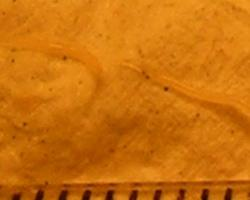
State of endangerment
| Non Endangered |
Animal description
Pinworms, scientifically known as Enterobius vermicularis, are small, parasitic nematodes that are primarily found in the human intestine, particularly in the colon and rectum. These worms are a common cause of intestinal infections, especially among children, due to their highly contagious nature. Enterobius vermicularis is recognized as one of the most prevalent parasitic worms in temperate and subtropical regions worldwide.Adult pinworms are white and slender, with females measuring about 8 to 13 mm in length, while males are significantly smaller, typically reaching only about 2 to 5 mm. The posterior end of the female is sharply pointed, which is a characteristic feature that gives the worm its common name. Males, on the other hand, have a curved posterior end.
The life cycle of Enterobius vermicularis is direct and does not require an intermediate host, making human-to-human transmission the primary mode of spread. The cycle begins when eggs are ingested or inhaled, often through contaminated hands, food, or surfaces. The microscopic eggs hatch in the small intestine, where the larvae emerge and mature. As they develop, the worms migrate to the colon, where they mate. Following mating, the male typically dies, while the gravid female migrates to the anus to deposit her eggs, usually at night. This migration can cause intense itching around the anus, leading to the hallmark symptom of a pinworm infection known as pruritus ani.
The eggs laid by the female worm are capable of surviving up to two weeks on surfaces, making them highly contagious. When another individual ingests these eggs, the cycle begins anew. The ease of transmission, particularly in crowded settings like schools and daycare centers, contributes to the high prevalence of pinworm infections among children.
Diagnosis of a pinworm infection, or enterobiasis, is typically achieved through the "tape test," where a piece of clear adhesive tape is pressed against the skin around the anus and then examined under a microscope for the presence of eggs. Treatment usually involves antiparasitic medications, with a second dose recommended two weeks after the first to ensure all worms and eggs are eradicated. Due to the high risk of reinfection, it is often recommended that all household members be treated simultaneously.
Preventive measures against pinworm infection include regular handwashing, maintaining clean living environments, and encouraging children to avoid scratching the anal area and to wash their hands regularly, especially before eating and after using the toilet.
In summary, Enterobius vermicularis, or the pinworm, is a common intestinal parasite that thrives in the human digestive tract. Despite its small size, it is a significant cause of discomfort and morbidity, particularly among children, due to its highly contagious nature and the intense itching caused by its reproductive habits. Effective treatment and prevention strategies are crucial in managing and controlling the spread of this pervasive parasite.
Similar Animals
New photos of animals
Top 10 animals
- Dolphin gull (Leucophaeus scoresbii)
- Diana monkey (Cercopithecus diana)
- Moustached guenon (Cercopithecus cephus)
- Galápagos tortoise (Geochelone nigra complex)
- Japanese macaque (Macaca fuscata)
- Stone loach (Barbatula barbatula)
- Russian tortoise (Testudo horsfieldii)
- Greek tortoise (Testudo graeca)
- Common flying dragon (Draco volans)
- Vendace (Coregonus albula)


